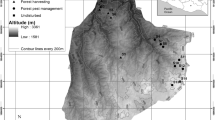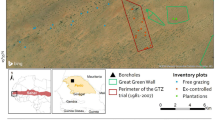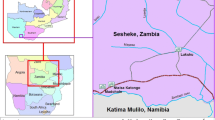Abstract
Seedling banks are very important in forest regeneration following forest disturbances such as crop cultivation. In 2011 and 2013 the Uganda National Forestry Authority (NFA) evicted encroachers from parts of Mabira Central Forest Reserve that had been under crop cultivation for over 40 years. This gave an opportunity for the vegetation to recover. In this study, we assessed the recovery process based on seedling bank diversity, richness and density in three blocks differing in recovery time. Two disturbed blocks, the Western Block (WB) (abandoned by encroachers 1–3 years), and the Eastern Block (EB) (abandoned 4–5 years) before this study and a nearby undisturbed area (intact) were included in the study. We recorded 48 seedlings species; 37 in WB, 30 in EB and 27 in intact. Differences in species richness were not statistically significant among blocks (F2, 88 = 1.2420, p = 0.294). All seedling species found in the intact were found in the EB and WB. There were statistically significant differences in species diversity (Shannon–Wiener: F2, 88 = 5.354, p = 0.006), density (P < 0.001) and composition (ANOSIM; R = 0.55, p = 0.001) among blocks. Apart from Broussonetia papyrifera, other species contributing to the dissimilarity (Acalypha neptunica, Antiaris toxicaria, Blighia unijugata, Funtumia elastica were late succession species. Animal dispersed species dominated intact. Seed-regenerating species were found in both WB and EB, but re-sprouts were more common in EB. These results show that proximity to intact forest aids forest recovery, even for areas with long-term cultivation history.



Similar content being viewed by others
References
Antos JA, Guest HJ, Parish R (2005) The tree seedling bank in an ancient Montane forest: stress tolerators in a productive environment. J Ecol 93:536–543
Baboo B, Sagar R, Bargali SS, Verma H (2017) Tree species composition, regeneration and diversity of an Indian dry tropical forest protected area. Trop Ecol 58:409–423
Babweteera F, Brown N (2010) Spatial patterns of tree recruitment in East African tropcial forests that have lost their vertebrate seed dispersers. J Trop Ecol 26:193–203
Bachelot B, Kobe RK, Vriesendorp (2015) Negative density-dependent mortality varies over time in a wet tropical forest, advantaging rare species, common species or no species. Oecologia 179:853–861
Baranga D (2007) Observations on resource use in Mabira Forest Reserve, Uganda. Afr J Ecol 45:2–6
Benitez-Malvido J (1998) Impact of forest fragmentation on seedling abundance in a tropical rain forest. Conserv Biol 12:380–389
Bongers F, Poorter L, Hawthorne WD, Sheil D (2009) The intermediate disturbance hypothesis applies to tropical forests, but disturbance contributes little to tree diversity. Ecol Lett 12:789–805
Caper RS, Chazdon RL, Brenes AR, Alvarado BV (2005) Successional dynmaics of woody seedling communities in wet tropical secondary forests. J Ecol 93:1071–1084
Carlson AR, Sibold JC, Negron JF (2020) Canopy structure and below canopy temperatures interact to shape seedling response to distrubance in a rocky mountain subalpine forest. Forest Ecol Manag 472 https://doi.org/10.1016/j.foreco.2020.118234
Chapman C, Chapman LJ (1997) Forest regeneration in logged and unlogged forests of Kibale national park, Uganda. Biotropica 29:396–412
Charles LS, Dwyer JM, Smith TJ, Connors S, Marschner P, Mayfield MM (2018) Species wood densityand the location of planted seedlings drive early-stage seedlingsurvival during tropical forest restoration. J Appl Ecol 55:1009–1018. https://doi.org/10.1111/1365-2664.1303
Colon SM, Lugo AE (2006) Recovery of a Subtropical dry forest after abandonment of different land uses. Biotropica 38:354–364
Connell JH (1978) Diversity in tropical rain forest and coral reefs. Science 199:1302–1310
Cordeiro NJ, Howe HF (2001) Low recruitment of trees dispersed by animals in African forest fragments. Conserv Biol 15:1733–1741
Dalling J, Brown J (2009) Long term persistence of pioneer species in tropical rain forest soil seed banks. Am Nat 173 https://doi.org/10.1086/597221
Davenport TRB, Howard PC, Baltzer M (1996) Mabira forest reserve: Biodiversity inventory report no. 13. Forest Department, Kampala
Devine MW (2004) Three Communities, Two Corporations, One Forest: Forest Resource Use and Conflict, Mabira forest, Uganda. Agroforestry in Landscape Mosaics Working Paper Series. World Agroforestry Centre, Yale University Tropical Resources Institute, and The University of Georgia.
Esaete J, Eycott AE, Reiniӧ J, Telford RJ, Vandvik V (2014) The Seed and Fern Spore Bank of a Recovering African Tropical Forest. Biotropica 46:677–686
Guariguata MR, Ostertag R (2001) Neotropical secondary forest succession: changes in structural and functional characteristics. For Ecol Manag 148:185–206
Geist HJ, Lambin EF (2002) Proximate causes and underlying drivers of tropical forest deforestation. Bioscience 52:143–150
Grace JB (1999) The factors controlling species density in herbaceous plant communities: as assessment. Perspect Plant Ecol EvolSyst 2:1–28
Grace JB, Pugesek BH (1997) A structural equation model of plant species richness and its application to a coastal wetland. Am Nat 149:436–460
Grime JP (1973) Control of species density in herbaceous vegetation. J Environ Manag 1:151–167
Gwali S, Agaba H, Balitta P, Hafashimana D, Nkandu J, Kuria A, Pinard F, Sinclair F (2015) Tree species diversity and abundance in coffee farms adjacent to areas of different disturbance histories in Mabira forest system, central Uganda. Int J Biodivers Sci Ecosyst Serv Manag 11:309–317
Haq SM, Rashid I, Khuroo AA, Malik ZA, Malik AH (2019) Anthropogenic disturbances alter community structure in the forest of Kashmir Himalaya. Tropical Ecol 60:6–15
Holl KD (2012) Tropical forest restoration. In: Van Andel J, Aronson J (eds) Restoration ecology. Blackwell, Malden, p 103–114
Holzmuleller EJ, Jose S, Jenkins MA (2009) The response of understory speciescomposition, diversity and seedling regeneration to repeated burning in Southern Appalachina Oak-Hickoryforests. Nat Areas J 29:255–262
Howard PC (1991) Nature conservation in Uganda’s tropical forest reserves. IUCN Tropical Forest Programme, Gland, Switzerland
Howard PC, Davenport TRB, Kigenyi FW, Viskanic P, Baltzer MC, Dickson CJ, Lwanga JL, Mathews RA, Mupada E (2000) Protected area planning in the tropics. Uganda’s Natl Syst For Nat reserves Conserv Biol 14:858–875
Howe HF (1996) Implications of seed dispersal by animals for tropical reserve management Biol Conserv 30:261–281 https://CRAN.R-project.org/package=vegan
Hu A, Zhang J, Chen XJ, Millner JP, Chang SH, Bowatte S, Hou RJ (2019) The composition, richness and evenness of seedlings from the soil seed bank of a semi-arid steppe in Northern China are affected by long term stocking rates of sheep and rainfall variation. Rangel J 41:23–32
Hubell SP, Foster RB, O’brien ST, Harms KE, Condit R, Wechster B, Wright CJ, Loo de Lao S (1999) Light-gap disturbance recruitment limitation and tree diversity in a Neotropical forest. Science 283 https://doi.org/10.1126/science.283.5401.554
Johnson DJ, Beaulieu WT, Bever JD, Clay K (2012) Conspecific negative density dependence and forest diversity. Science 336:904. https://doi.org/10.1126/science.1220269
Katishima S, Morita S, Yoshida K, Ishida A, Hayashi S, Asami T, Ito H, Miller DG, Uehara T, Hasegawa E, Matsuura K, Kasuya E, Yoshimura J (2015). The contribution of seed dispersers to tree diversity in tropical rainforests. R Soc Open Sci https://doi.org/10.1098/rsos.150330
Kent M (2012) Vegetation Description and data analysis: a practical approach, Second edition. John Wiley and Sons ltd, Uk
Kirika JM, Böhning-Gaese K, Dumbo B, Farwing N (2010) Reduced abundance of late successional trees but not of seedlings in heavily compared to lightly logged sites of three East African Tropical forests. J Trop Ecol 26:533–546
Li X, Liu W, Tang CQ (2010) The role of the seed and seedling bank in the regeneration of diverse plant communities in subtropical Ailao Mountains, Southwest China. Ecol Res 25:1171–1182
Ligate EJ, Wu C, Chen C (2019) Investigation of tropical coastal forest regeneration after farming and livestock grazing exclusion. J Res 30:1873–1884
Magee L, Wolf A, Howe R, Schubbe J, Hagenow K, Turner B (2021) Density dependence and habitat heterogeneity regulate seedling survival in a North American temperate forest. Forest Ecology and Management. https://doi.org/10.1016/j.foreco.2020.118722
Ministry of Water, Lands and Environment (2017) Forest Sector Review Report. Unpublished report, Government of Uganda.
Mugwedi LF, Rouget M, Egoh B, Sershen, Ramdhani S, Slotow R, Renteria JL (2017) An assessment of a community–based forest restoration programme in Durban (e Thekwini), South Africa. Forests 8:255. https://doi.org/10.3390/f8080255
Mulugo LW, Galabuzi C, Nabanoga GN, Turyahabwe N, Eilu G, Obua J, Kakudidi E, Sibelet N (2020) Cultural knowledge of forests and allied tree system management around Mabira Forest Reserve, Uganda. J Forest Res 31:1787–1802. https://doi.org/10.1007/s11676-019-00961-6
Mwampamba TH, Schwartz M (2011) The effects of cultivation history on forest recovery in fallows in Eastern Arc Mountain, Tanzania. For Ecol Manag 261:1042–1052
Mwavu NE, Witkowski ETF (2009) Seedling regeneration, environment and management in a semi-deciduous African tropical rain forest. J Veg Sci 20:791–804
National Forestry Authority (2008) Strategic action plan for the period 2008/9 to 2012/13 with priorities for the first five years. Government of Uganda, Kampala
Oksanen J, Blanchet FG, Friendly M, Kindt R, Legendre P, McGlinn D, Minchin PR, O’Hara RB, Simpson GL, Solymos P, Stevens MHH, Szoecs E, Wagner H (2020) vegan: Community Ecology Package. R package version 2.5-7. https://CRAN.R-project.org/package=vegan.
Pérez-García O, del Castillo RF (2017) Shifts in swidden agriculture alter the diversity of young fallows: Is the regeneration of cloud forest at stake in southern Mexico? Agric Ecosyst Environ 248:162–174
Pillay R, Hua F, Lioselle B, Benard H, Fletcher RJ (2018) Multiple stages of tree seedling recruitment are altered in tropical forests degraded by selective logging. Ecol Evol 8:8231–8242. https://doi.org/10.1002/ece3.4352
Plumptre AJ (1995) Importance of ‘seed trees’ for the natural regeneration of selectively logged forest. Common Wealth Forest Rev 74:253–258
Pollock MM, Naiman RJ, Hanley TA (1998) Plant species richness in riparian wetlands. A test of biodiversity theory. Ecology 79:94–105
Poorter L, Kitajima K, Mercado P, Chubina J, Melgar I, Prins HH (2010) Resprouting as a persistence strategy of tropical forest trees: relations with carbohydrate storage and shade tolerance. Ecology 91:2613–2627
R Core Team (2021) R: A language and environment for statistical computing. R Foundation for Statistical Computing, Vienna, Austria, https://www.R-project.org/
Senbeta F, Teketay D (2002) Soil seed banks in plantations and adjacent natural dry Afromontane forests of central and Southern Ethiopia. Trop Ecol 43:229–242
Souza JT, Ferraz EMN, Albuquerque UP, Araujo EL (2013) Does proximity to a mature forest contribute to the seed rain and recovery of an abandoned agricultural area in a semiarid climate? Plant Biol 16:748–756. https://doi.org/10.1111/plb.12120
Ssekubwa E, Muwanika V, Esaete J, Tabuti J, Tweheyo M (2018) Colonization of woody seedlings in the understory of actively and passively restored tropical moist forests. Restor Ecol https://doi.org/10.1111/rec.12850
Teegalapalli K, Gopi GV, Samal PK (2009) Forest recovery following shifting cultivation: an overview of existing research. Tropical Conservation. Science 2:374–387. www.tropicalconservationscience.org
Tilman D (1983) Plant succession and gopher disturbance along an experimental gradient. Oecologia 60:285–292
Wickham H (2016) ggplot2: elegant graphics for data analysis. Springer-Verlag, New York, NY ISBN 978-3-319-24277-4, https://ggplot2.tidyverse.org
Wilson SD, Tilman D (1991) Interactive effects of fertilization and disturbance on community structure and resource availability in old-field plant community. Oecologia 88:61–71
Wolfe BT, Macchiavelli R, Van Bloem SJ (2019) Seed rain along a gradient of degradation in Caribbean dry forest: Effects of dispersal limitation on the trajectory of forest recovery. Appl Veg Sci https://doi.org/10.1111/avsc.12444
Yan QL, Zhu JJ, Yu LZ (2012) Seed regeneration potential of canopy gaps at early formation stage in temperate secondary forest, Northeast China. PLoS ONE 7:e39502. https://doi.org/10.1371/journal.pone.0039502
Acknowledgements
NORAD through the Norwegian Program for Capacity Development in Higher Education and Research for Development (NORHED) project (UGA-13/0019) financed this study. Uganda national Council for Science and Technology (NS 511) provided permission for the study. We are grateful to the Ugandan National Forest Authority (NFA) for permitting access to Mabira CFR, to the staff of the Herbarium of Makerere University for specimen identification. We thank the conference organizing committee for supporting the conference participants.
Author information
Authors and Affiliations
Corresponding author
Ethics declarations
Conflict of Interest
The authors declare no competing interests.
Additional information
Publisher’s note Springer Nature remains neutral with regard to jurisdictional claims in published maps and institutional affiliations.
Appendix 1
Appendix 1
Tree and seedling species abundance (1 ha) in formerly cultivated (WB Western Block and EB Eastern Block) and intact areas in Mabira Central Forest Reserve
Species | Family | Trees | Seedlings | ||||
|---|---|---|---|---|---|---|---|
WB | EB | Intact | WB | EB | Intact | ||
Acacia spp | Fabaceae | 20,800 | |||||
Acalypha fruticosa Forssk. | Euphorbiaceae | 50,000 | 74,400 | 3200 | |||
Acalypha neptunica Müll.Arg. | Euphorbiaceae | 58,000 | 36,000 | 46,800 | |||
Albizia glaberrima (Schum. and Thonn.) Benth. | Mimosaceae | 33.3 | 133.3 | 400 | 2400 | ||
Albizia grandibracteata Taub. | Mimosaceae | 400 | 800 | ||||
Albizia wightii Wight and Arn | Mimosaceae | 66.7 | 33.3 | ||||
Albizia zygia (DC.) J.F.Macbr. | Mimosaceae | 33.3 | 400 | 5600 | 170,400 | 2800 | |
Aphania spp | Sapindaceae | 33.3 | |||||
Alstonia boonei De Wild. | Apocynaceae | 33.3 | 33.3 | 133.3 | 400 | ||
Antariaris toxicaria Lesch. | Moraceae | 133.3 | 66.7 | 100 | 18,400 | 37,200 | 46,000 |
Aphania senegalensis (Poir.) Radlk. | Sapindaceae | 266.7 | 7200 | 67,200 | 17,600 | ||
Artocarpus heterophyllus Lam. | Moraceae | 66.7 | 33.3 | ||||
Blighia unijugata Baker | Sapindaceae | 33.3 | 366.7 | 46,800 | 22,800 | 24,400 | |
Broussonetia papyrifera (L.) L’Hér. ex Vent. | Moraceae | 8333.3 | 1100 | 1200 | 438,000 | 133,600 | 44,800 |
Canarium schweifurthii Engl. | Burseracece | 400 | |||||
Celtis Africana Burm.F. | Celtidaceae | 33.3 | 666.7 | 65,600 | 2400 | ||
Celtis durandii Engl. | Cananabaceae | 533.3 | 2000 | 3600 | |||
Celtis mildbraedii Engl. | Cananabaceae | 933.3 | 5200 | 10,000 | 41,600 | ||
Celtis wightii Planch. | Cananabaceae | 66.7 | |||||
Clausena anisata (Willd.) Hook.f. ex Benth | Rutaceae | 400 | |||||
Coffea ligustroides S.Moore | Rubiaceae | 13,600 | 3200 | ||||
Cola gigantea A.Chev. | Sterculiaceae | 233.3 | 66.7 | 800 | 18,800 | 38,800 | |
Cordia Africana Lam. | Boraginaceous | 4800 | |||||
Entandrophragma angolense (Welw.) C.DC. | Meliaceae | 333.3 | 2800 | 18,000 | 10,000 | ||
Ficus asperifolia Miq. | Moraceae | 11,200 | 69,600 | ||||
Ficus capensis Thunb. | Moraceae | 66.7 | 200 | 233.3 | 400 | 2400 | 8400 |
Ficus exasperata Vahl | Moraceae | 33.3 | 100 | 333.3 | 9200 | 28,400 | 10,400 |
Ficus mucuso Welw. ex Ficalho | Moraceae | 233.3 | 1200 | ||||
Ficus sur Forssk. | Moraceae | 33.3 | 1600 | ||||
Funtumia elastica (Preuss) Stapf | Apocynaceae | 166.7 | 1033.3 | 1100 | 28,400 | 23,200 | 25,600 |
Khaya senegalensis (Desv.) A.Juss. | Meliaceae | 133.3 | 1600 | 800 | |||
Kigelia africana (Lam.) Benth. | Bignoniaceae | 33.3 | 1200 | ||||
Macaranga lancifolia Pax | Euphorbiaceae | 33.3 | |||||
Margaritaria discoidea (Baill.) G.L.Webster | Euphorbiaceae | 233.3 | 4800 | 3200 | 7600 | ||
Manilkara dawei (Stapf) Chiov. | Sapotaceae | 33.3 | 5200 | 44,400 | |||
Markhamia lutea (Benth.) K.Schum. | Bignoniaceae | 33.3 | 66.7 | 39600 | 14,800 | ||
Maesopsis eminii Engl. | Rhamnaceae | 33.3 | 133.3 | ||||
Milicia excelsa (Welw.) C.C.Berg | Moraceae | 33.3 | 33.3 | 14,800 | |||
Monodora angolensis Welw. | Annonaceae | 100 | 7600 | 11200 | |||
Myrianthus arboreus P.Beauv. | Urticaceae | 333.3 | 2800 | 800 | |||
Newtonia buchananii (Baker) G.C.C.Gilbert and Boutiqu | Fabaceae | 100 | 400 | 7200 | |||
Pachystela brevipes (Baker) Baill. | Sapotaceae | 200 | 10,800 | 12000 | |||
Polyscias fulva (Hiern) Harms | Apocynaceae | 33.3 | 200 | 800 | |||
Prunus africana (Hook.f.) Kalkman | Rosaceae | 2800 | |||||
Psidium guajava L. | Myrataceae | 400 | |||||
Sapium ellipticum (Hochst.) Pax | Euphorbiaceae | 66.7 | 33.3 | 1200 | |||
Schrebera arborea A.Chev. | Oleaceae | 33.3 | |||||
Spathodea campanulata P.Beauv. | Bignoniaceae | 66.7 | 33.3 | 3200 | |||
Sterculia dawei Sprague | Sterculiaceae | 100 | 4000 | ||||
Tabernaemontana holstii K.Schum. | Apocynaceae | 600 | 10,000 | 22,000 | |||
Tamarindus indica L. | Fabaceae | 33.3 | 33.3 | 400 | 800 | ||
Teclea nobilis Delile | Rutaceae | 233.3 | 1200 | 12,000 | 26,200 | ||
Terminalia brownii Fresen. | Combretaceae | 800 | |||||
Treculia africana Decne. ex Trécul | Moraceae | 800 | |||||
Trema orientalis (L.) Blume | Cannabaceae | 33.3 | |||||
Trichilia spp | Meliaceae | 6000 | |||||
Vernonia amygdalina Delile | Asteraceae | 133.3 | |||||
Rights and permissions
About this article
Cite this article
Esaete, J., Muwanika, V.B., Musiba, R. et al. Understorey Seedling Bank in Forest Areas with a Differing Period of Recovery in Mabira Central Forest Reserve, South Central Uganda. Environmental Management 71, 159–169 (2023). https://doi.org/10.1007/s00267-022-01637-4
Received:
Accepted:
Published:
Issue Date:
DOI: https://doi.org/10.1007/s00267-022-01637-4




